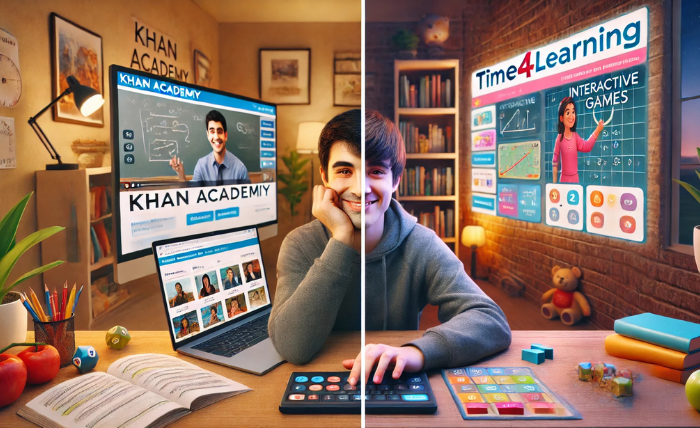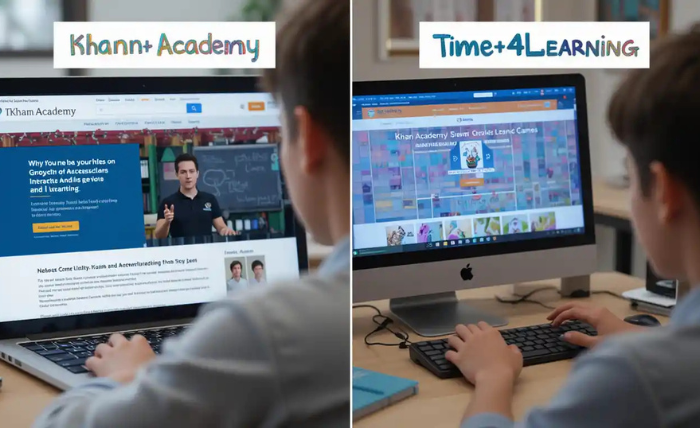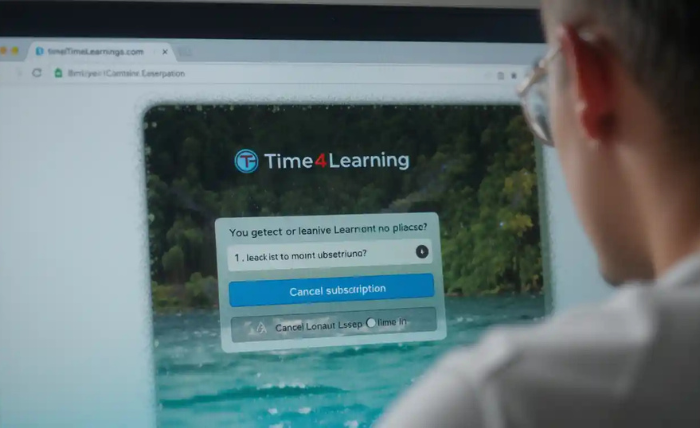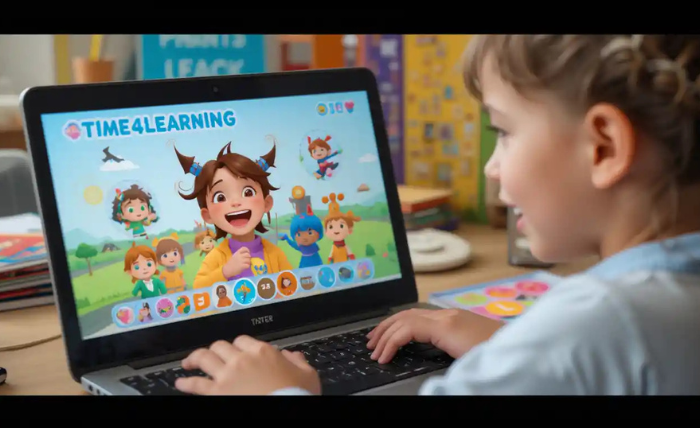Online learning platforms have become incredibly popular, especially for parents looking to support their child’s education at home. Two of the most well-known platforms are Khan Academy and Time4Learning. But which one is the best for your child? In this article, we’ll compare Khan Academy vs Time4Learning to help you make an informed decision about which platform works best for your child’s needs.
Both platforms have their strengths, but understanding their unique features, pricing models, and the types of support they provide can help you decide. Let’s dive into this Time4Learning vs Khan Academy comparison and explore their key differences.
What is Khan Academy?
Khan Academy is a popular, free online learning platform that offers educational videos and exercises for students of all ages. It covers a wide range of subjects, including math, science, history, and even arts and humanities. The platform is known for its easy-to-follow video lessons and practice exercises that help students master concepts at their own pace.
Khan Academy Features
- Free Access: One of the biggest draws of Khan Academy is that it is entirely free. Students can access all the lessons, exercises, and materials without any cost.
- Wide Subject Range: Khan Academy offers content for subjects from elementary school to college-level courses, making it a versatile platform.
- Interactive Exercises: In addition to videos, Khan Academy offers practice exercises where students can apply what they’ve learned and get immediate feedback.
What is Time4Learning?
Time4Learning is another highly regarded online learning platform, but it’s a paid service. It’s designed to offer a more structured, curriculum-based approach to learning. Time4Learning focuses on a range of subjects like math, language arts, science, and social studies for children in preschool through middle school.
Time4Learning Features
- Paid Service: Unlike Khan Academy, Time4Learning requires a subscription, but it offers a more structured approach to learning with detailed lesson plans and a full curriculum.
- Interactive Learning: Time4Learning incorporates games, quizzes, and activities to make lessons more engaging and fun.
- Progress Tracking: Time4Learning offers tools for parents to monitor their child’s progress, including reports on completed lessons and areas that need improvement.
Khan Academy vs Time4Learning: Pricing Comparison
Pricing is a big factor when comparing Khan Academy vs Time4Learning. Here’s a breakdown of what you can expect from both platforms:
Khan Academy Pricing
- Completely Free: Khan Academy is available for free, making it an excellent choice for parents on a budget. Students can access all lessons and practice exercises without paying a penny.
- Optional Donations: While the platform is free, Khan Academy does accept donations to help support its mission. However, these donations are not required for access to the platform.
Time4Learning Pricing
- Paid Subscription: Unlike Khan Academy, Time4Learning requires a monthly or annual subscription. Pricing can vary based on the age of the child and the number of subjects you choose. It is generally affordable, but not free.
- Discounts Available: Time4Learning often offers discounts or promotions, so it’s worth checking for deals.
Khan Academy vs Time4Learning: Which Platform is More Interactive?
One of the key factors in determining which platform is better for your child is how interactive the learning experience is. Let’s look at how each platform engages students.
Khan Academy’s Interactive Features
- Videos: Khan Academy uses video lessons as its primary teaching tool. These videos are great for explaining concepts in detail, but they don’t offer the same level of hands-on interaction as some other platforms.
- Practice Exercises: After watching a video, students can complete practice exercises to reinforce what they’ve learned. The exercises are interactive and offer instant feedback, but they are more focused on practicing concepts than on engaging students with fun activities.
Time4Learning’s Interactive Features
- Games and Activities: Time4Learning offers a variety of interactive activities, games, and quizzes. These tools make the learning process more fun and encourage students to stay engaged.
- Visual Learning: Time4Learning uses animations and colorful visuals to help explain lessons, which makes it particularly appealing for younger learners who benefit from visual cues.
Khan Academy vs Time4Learning: The Curriculum
Both Khan Academy vs Time4Learning offer a wide range of subjects, but they approach curriculum delivery in different ways.

Khan Academy Curriculum
- Flexible Learning: Khan Academy’s curriculum is flexible. Students can choose what to learn and when to learn it. The self-paced nature of the platform is great for students who want to explore topics at their own pace.
- Comprehensive Lessons: The lessons are designed to help students master specific concepts in a subject, but the platform doesn’t provide a full, step-by-step curriculum. This means parents or teachers may need to supplement Khan Academy with other resources.
Time4Learning Curriculum
- Structured Learning Path: Time4Learning offers a complete, structured curriculum for students from preschool through middle school. It provides a more organized learning experience with predefined lessons, making it easier for parents to follow a set plan.
- Subject Focus: Time4Learning offers comprehensive courses in subjects like math, science, language arts, and social studies. The platform provides a wide range of resources, including interactive lessons, worksheets, and quizzes, making it an ideal choice for families looking for a full curriculum.
Khan Academy vs Time4Learning: Parental Involvement
For many parents, monitoring their child’s progress is a priority when choosing an online learning platform. Let’s see how Khan Academy vs Time4Learning compare in terms of parental involvement.
Khan Academy Parental Involvement
- Reports and Tracking: Khan Academy allows parents to track their child’s progress by viewing reports on completed exercises and mastery of topics. This helps parents see which areas their child needs help with.
- Self-Paced Learning: Since the platform is self-paced, parents may need to check in regularly to ensure that their child stays on track and is engaging with the lessons.
Time4Learning Parental Involvement
- Progress Reports: Time4Learning offers detailed progress reports that help parents track their child’s progress in real-time. Parents can easily see which lessons have been completed and which areas need improvement.
- Parent Dashboard: Time4Learning has a parent dashboard that provides a clear overview of the child’s learning path, assignments, and completed lessons. This makes it easier for parents to be actively involved in their child’s education.
Khan Academy vs Time4Learning: Which Platform is Better for Your Child?
Choosing between Khan Academy vs Time4Learning depends on your child’s learning style, your budget, and what you’re looking for in an online learning platform.
- Khan Academy is best if you’re looking for a free, flexible, and self-paced platform. It’s great for families on a budget or those who prefer their children to learn at their own pace without a set curriculum.
- Time4Learning is a better choice if you’re looking for a structured, full curriculum with interactive lessons, games, and progress tracking. It’s ideal for parents who want a comprehensive, organized learning experience for their child.
Conclusion: Khan Academy vs Time4Learning – Which is Right for You?
In the battle of Khan Academy vs Time4Learning, both platforms have their unique strengths. Khan Academy offers free, self-paced learning that works well for students who prefer to explore subjects independently. On the other hand, Time4Learning offers a complete, structured curriculum with interactive tools and strong parental involvement, making it a great option for families looking for a more guided learning experience.
Ultimately, the best choice depends on your child’s needs and your family’s preferences. If you’re still unsure, it may be helpful to try both platforms and see which one your child enjoys most.





